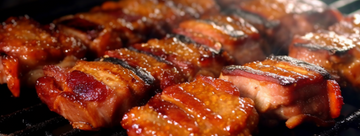
Dried Chillies
Chilli peppers are about so much more than heat!
There are over 4,000 types of chillies cultivated for cooking, each with its own flavor and level of spiciness. Many of these are grown specifically for drying to preserve their fruity flavor, and these dried chillies are essential ingredients in cuisines across the world, from the mountains of Peru to the tropical valleys of China. It’s never been easier for cooks to sample high quality versions from specialty spice companies, so if you haven’t ventured beyond the grocery store crushed red pepper and cayenne, now’s an excellent time!

The making of dried chillies
“Chilli” descends from the Nahuatl word chīlli. In Spanish-speaking regions of Latin America, where the plants grow wild, the peppers are spelled as chile. Almost all of those 4,000 pepper varieties come from just five species of vining plants in the genus Capsicum, which is part of the nightshade family along with tomatoes, potatoes, and eggplants. Individual varieties are cultivated like dog breeds for a specific color, flavor, size, and heat. Drying chilli peppers impacts the flavor as well. Some varieties are slowly dried over fires to develop a potent smokiness, while others sweat it out under blankets in the sun, which slightly oxidizes the pepper for a richer, fuller flavour.

What makes a quality dried chilli?
What is Regardless of the variety, a quality whole dried chilli should be soft and bendable, even a little moist, with a vivid color and obvious aroma. Despite the term “dried,” fresh dried chillies are more akin to raisins and sun-dried tomatoes than other spices. A crispy, brittle chilli is dried-out chilli that’s been on store shelves too long. To taste dried chiles at their peak, use whole dried chillies within six months and grind them in your FinaMill (use the Max pod, the black one) as needed. Ground chillies lose flavour quickly and are best used within a month

Three general pepper predilections to find your new favourite variety
It’s easy to get overwhelmed at the sheer number of chilli peppers to choose from. While there are exceptions to each of these guidelines, here are three general pepper predilections to help you find your new favourite variety.
- Smaller chillis (habanero, cascabel, Scotch bonnet) tend to be hotter than large chiles (ancho, pasilla, guajillo).
- Most dried chillis appear in shades of red or purplish black. Red chillis usually have a brighter, sunnier flavor with a sharp acidity; black chillis taste darker and richer with flavors of raisins and chocolate. Try mixing the two in a single dish for the best of both worlds! Black chillis are often less spicy as well.
- When in doubt of a chilli’s spiciness, consult the Scoville scale, a relative measurement of a pepper’s spiciness. The higher the number, the greater the concentration of capsaicin, the molecule responsible for chilli heat. Just remember these are averages; an individual pepper might be hotter or milder than you expect. Consider it part of the Russian roulette fun of playing with your peppers!
Grab FinaPod MAX (Black) to grind your dried chilli for best results! If it's a whole chilli, make sure you chop them into small sections first.




